Melbourne tram classification
Melbourne's tram classification system is based on classes originally devised by the Melbourne & Metropolitan Tramways Board (M&MTB).[1] At first this was largely based on the order in which the original tramway operators had introduced each different type of tramcar between 1906 and 1920.[1]
The classification system was simplified in 1928[1] (or possibly earlier). All the drop-end combination trams of the B, H, J, M, and S classes were added to A class. The straight sill combination classes F, K, Q, and R, were added to G class. Drop-end-and-centre Maximum traction bogie combination classes D, E, N, and P, were added to C class. Sometimes variations on a design were given extra letters or numerals. For example, W type trams classified as W3, CW5, or SW6. Over the years many of the trams were modified and then reclassified – for example, every one of the original 200 W class trams were converted to W2 class between 1928 and 1933.[1]
Individual tram fleets had been numbered (from 1 upwards) by each of the pre-M&MTB tramway operators, but by 1924 the M&MTB had consolidated the numbering across the combined fleet.[1] With the introduction of Z class trams, the M&MTB started a new numbering system.[1] Tramways in Ballarat, Bendigo, Geelong, Sorrento and the Victorian Railways had their own tram numbering systems. Trams which were moved between the systems were renumbered.
There were also many non-passenger trams, such as rail grinders, breakdown cars and freight cars which were not included in the classification system.
Classes
| Image | Class | Description | Fleet numbers |
|---|---|---|---|
| A class | Single truck, drop end, open California combination, built by Duncan & Fraser (1910–1911) for PMTT[1]: 49 | 1–20 | |
| B class | Single truck, drop end, open California combination, built by James Moore & Sons (1917–1918) for PMTT[1]: 50 | 21–24, 84–91 | |
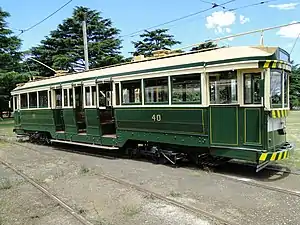 | C class | Maximum traction, bogie, drop end and centre combination, built by Duncan & Fraser (1913) for PMTT[1]: 51 | 25–35 |
| D class | Maximum traction, bogie, drop end and centre combination, built by Duncan & Fraser (1914) for PMTT[1]: 51 | 36 | |
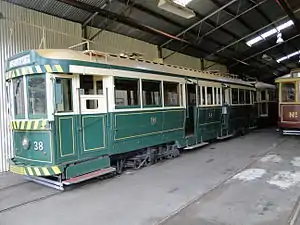 | E class | Maximum traction, bogie, drop end and centre combination, built by Duncan & Fraser (1914) for PMTT[1]: 52 | 36–45 |
| F class | Single truck, straight sill, clerestory-roofed, single aisle summer car, built by Duncan & Fraser (1912) for PMTT[1]: 52 | 46–47 | |
| G class | Single truck, straight sill, single aisle summer car, built by Duncan & Fraser (1913) for PMTT[1]: 53 | 48–53 | |
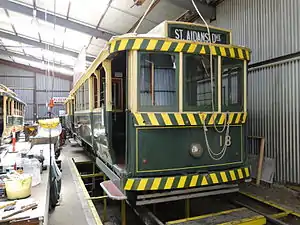 | H class | Single truck, drop end, open California combination, built by Duncan & Fraser (1913) for PMTT[1]: 54 | 54–63 |
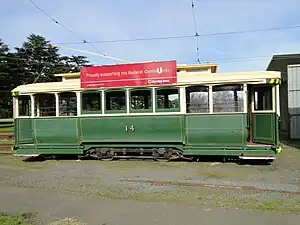 | J class | Single truck, drop end, open California combination, built by Meadowbank Manufacturing Company (1915) for PMTT[1]: 54 | 64–83 |
| K class | Single truck, drop end, open California combination, built by Moore (1919–1920) for PMTT[1]: 55 | 92–100 | |
| L class | Bogie combination, built by James Moore & Sons (1921) for PMTT[1]: 56 | 101–106 | |
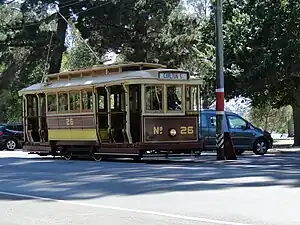 | M class | Single truck, drop end, open California combination, built by Duncan & Fraser (1917) for HTT and FTT[1]: 58 | 107–116, 183–189 |
 | N class | Maximum traction, bogie, drop end and centre combination, built by Duncan & Fraser (1916) for HTT[1]: 59 | 117–126 |
| O class | Maximum traction, bogie, straight sill, combination with one drop end, built by Duncan & Fraser (1912) for PMTT[1]: 60 | 127–130 | |
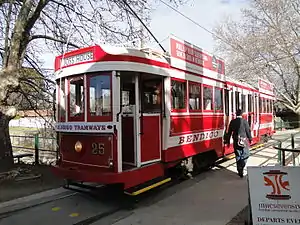 | P class | Maximum traction, bogie, drop end and centre combination, built by Duncan & Fraser (1917–18) for HTT[1]: 61 | 131–138 |
| Q class | Single truck, straight sill, closed combination, built by MMTB (1922–1923)[1]: 62 | 139–150, 190–201 | |
| R class | Single truck, straight sill, closed combination, built by James Moore & Sons (1920) for FNPTT[1]: 63 | 151–153 | |
| R class | Single truck, straight sill, closed combination, built by MMTB (1920)[1]: 63 | 172–176 | |
| S class | Single truck, drop end, open California combination built by Duncan & Fraser (1916–1922) for MBCTT and MMTB[1]: 64 | 154–171 | |
| T class | Single truck, drop end, open combination with long saloon, built by Duncan & Fraser (1917) for MBCTT[1]: 65 | 177–182 | |
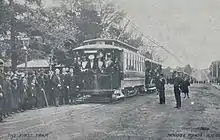 | U class | Single truck, saloon, built by Duncan & Fraser (1906) for NMETL[1]: 66 | 202–211 |
| V class | Single truck, open cross bench, built by Duncan & Fraser (1906) for NMETL[1]: 67 | 212–216 | |
| W class | Bogie drop centre combination, built 1923–1927 by Holden, James Moore & Sons and MMTB[1]: 23 : 112 | 219–418 | |
| W1 class | Bogie drop centre combination, built by MMTB (1925–1928)[1]: 25 | 419–438, 470–479 | |
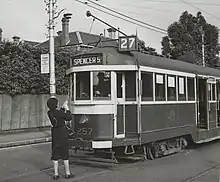 | W2 class | Bogie drop centre combination, built by MMTB and James Moore & Sons (1927–31)[1]: 26 | 439–458, 480–609, 624–653 |
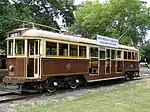 | W3 class | Bogie drop centre combination, built MMTB (1930–1934)[1]: 32 | 654–669 |
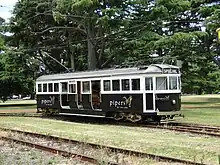 | W4 class | Bogie drop centre combination, built MMTB (1933–1935) | 670–674 |
| CW5 class | Maximum traction, bogie, drop centre combination, built MMTB (1934–1935)[1]: 38 | 681–685 | |
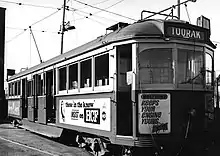 | W5 class | Bogie, drop centre combination, built by MMTB (1935–1939)[1]: 35 | 720–839 |
| SW2 class | Bogie drop centre saloon, built by MMTB (1938, 1953, 1955)[1]: 37 | 275, 426, 432, 436, 478, 644 | |
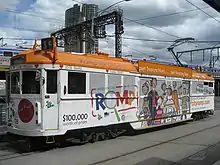 | SW5 class | Bogie, drop centre saloon, built by MMTB (1939–1940, 840–849), converted by Metropolitan Transit Authority (1983–1986, all the other tram cars) [2] | 681–682, 721–734, 736–750, 752–755, 757–760, 764–765, 767–770, 773, 775–777, 780–781, 784–791, 793, 796–797, 800, 802, 805–812, 814–816, 818–819, 824, 828–830, 834, 836–838, 840–849 |
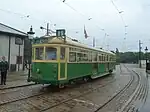 | SW6 class | Bogie drop centre saloon, built by MMTB (1939–1951)[1]: 40 | 850–969 |
| PCC class (1950) | Two door bogie saloon, built by MMTB (1950)[1]: 42 | 980 | |
.jpg.webp) | W6 class | Bogie, drop centre saloon, built by MMTB (1951–1955)[1]: 43 | 970–979, 981–1000 |
.jpg.webp) | W7 class | Two door bogie saloon, built by MMTB (1955–1956)[1]: 42 | 1001–1040 |
| W8 class | Bogie drop centre saloon, converted from SW6/W6/W7 trams 946, 959 (2013), 957 (2015), 1010 (2016), 983 (2017), 856, 928, 961 (2019), 888 (2020)[3] | 856, 888, 928, 946, 957, 959, 961, 981, 983, 1010 | |
| X class | Single truck saloon safety car, built by JG Brill Company & St Louis Car Company (1923)[1]: 22 | 217–218 | |
| X1 class | Single truck saloon, built by MMTB (1926–1928)[1]: 28 | 459–468 | |
| X2 class | Single truck saloon, built by MMTB (1930)[1]: 30 | 674 (later 680), 675–679 | |
| Y class | Bogie saloon, built by MMTB (1927)[1]: 29 | 469 | |
| Y1 class | Bogie saloon, built by MMTB (1930)[1]: 31 | 610–613 | |
 PCC class (1950) | PCC class (1973) | Prototype two door bogie saloon, last ever tram built by MMTB (1973).[4][5] Formed the basis of the Z1 class tram design | 1041 |
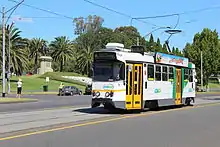 | Z1 class | Two door bogie saloon, built by Comeng (1974–1978)[1]: 13 | 1–100 |
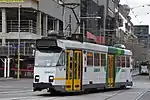 | Z2 class | Two door bogie saloon, built by Comeng (1978–1979)[1]: 13 | 101–115 |
_in_Swanston_St%252C_December_2013.JPG.webp) | Z3 class | Three door bogie saloon, built by Comeng (1979–1984)[1]: 16 | 116–230 |
_in_Bourke_St%252C_December_2013.JPG.webp) | A1 class | Three door bogie saloon, built by Comeng (1983–1985) | 231–258 |
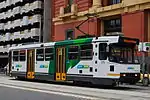 | A2 class | Three door bogie saloon, built by Comeng (1985–1987) | 259–300 |
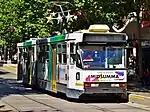 | B1 class | Articulated saloon, built by Comeng (1984–1985)[1]: 19 | 2001–2002 |
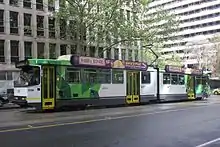 | B2 class | Articulated saloon, built by Comeng (1987–1994) | 2003–2132 |
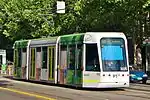 | C1 class | Three-section articulated saloon, low floor Alstom Citadis 202 tram(2001–2002) | 3001–3036 |
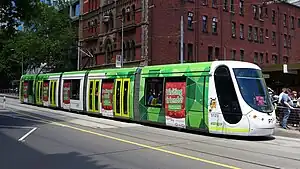 | C2 class | Five-section articulated saloon, low floor Alstom Citadis 302 trams (2008)[6] | 5103, 5106, 5111, 5113, 5123 |
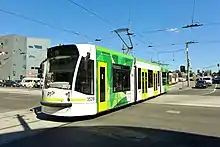 | D1 class | Three section, low floor Combino trams, made by Siemens (2002–2003)[7] | 3501–3538 |
_in_Elizabeth_St_on_route_19_to_City_in_PTV_livery%252C_December_2013.jpg.webp) | D2 class | Five section, low floor Combino trams, made by Siemens (2003–2004)[8] | 5001–5021 |
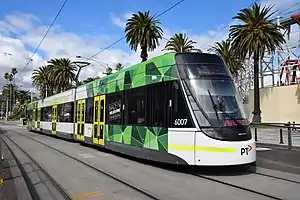 | E1 class | Three-section, four-bogie articulated trams built by Bombardier Transportation (2013–2017)[9] | 6001–6050 |
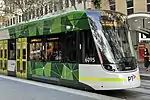 | E2 class | Three-section, four-bogie articulated trams built by Bombardier Transportation (2017–)[10] | 6051–6090 |
References
- Cross, Norman (2001). Destination City. Sydney: Transit Australia. ISBN 0-909459-17-7.
- "SW5 Class". vicsig.net.
- "W8 Class". vicsig.net.
- "PCC.1041". vicsig.net. Retrieved 10 October 2023.
- "Melbourne & Metropolitan Tramways Board PCC No 1041". Melbourne Tram Museum. Retrieved 10 October 2023.
- "C2 Class, VICSIG – Trams". vicsig.net. 2013. Retrieved 31 December 2013.
- "D1 class, VICSIG – Trams". vicsig.net. 2013. Retrieved 31 December 2013.
- "D2 class, VICSIG – Trams". vicsig.net. 2013. Retrieved 31 December 2013.
- "E class, VICSIG – Trams". vicsig.net. 2013. Retrieved 31 December 2013.
- "E2 class, Trams DownUnder". Retrieved 9 April 2018.